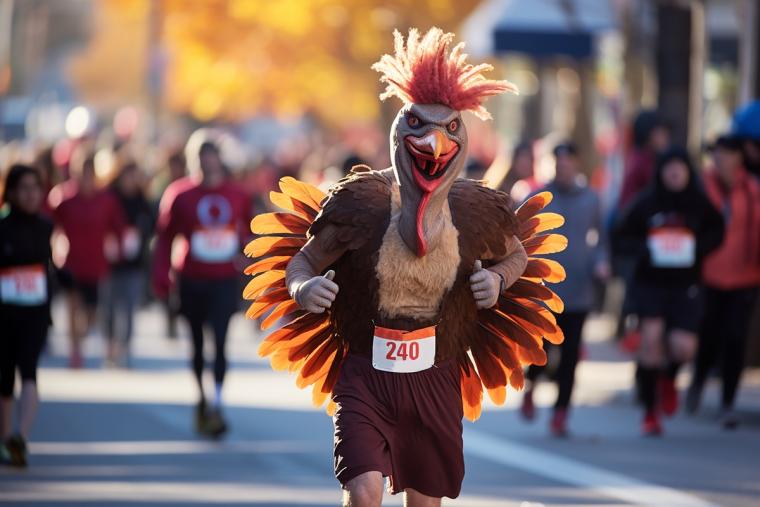
Traditionally, turkey trots have been one of the biggest cash cows of Thanksgiving, according to Running USA, which in a 2018 study (the last one made on the subject), noted that nearly 1.2 million runners were participating.
Then there were the dark days of the pandemic but now, say race organizers, the event has returned in all its glory.
“Thanksgiving Day racing has largely returned after a 75% drop in participation in 2020,” notes the event registration platform, RunSignUp. “Registrations on RunSignup were up 22% compared to 2021 and 41% compared to 2019. For context, that’s essentially the entire population of Seattle, WA, running on the same morning (and registering on RunSignup).”
Additionally, turkey trots are a massive contributor to economic impact, accounting for the biggest U.S. running day of the year. Last year, Thanksgiving Day races raised more than $1.8 million dollars for charities and took in countless canned goods for donations to local food banks.
To get an inside look at these numbers, SDM checked the website, Running in the USA, which tracks race participation. A typical Thursday has, well, no races, unless meet-ups of running clubs count, in which case, there might be one or two – per month. But on Thanksgiving Day 2023, at last check, there were nearly 1,000 5K races (5K being the typical turkey trot race distance), about 250 races with a distance of 2K or lower, and about 200 10Ks. And that was just at the time of writing; new races are added constantly, so it is likely those numbers will soar.
Some races are local, put on by organizations like YMCAs or food banks, but others have established themselves as go-to events. One of those is the San Diego-based O’Side Turkey Trot, which, according to Runner’s World, attracts visitors from 46 states and 460 cities and benefits the Move Your Feet Before You Eat!® Foundation.
Nationwide, it is the biggest race day of the year. How it got that way… well, nobody really knows, but Runner’s World has a great history of how it started. Here is an excerpt:
 “The inaugural trot took place 125 years ago in Buffalo, New York. The local YMCA hosted an 8K cross-country race that Thanksgiving Day, drawing just six participants—and only four of them made it to the finish line. One runner excused himself after two miles; another dropped out when his “late breakfast refused to keep in its proper place.” The winner, Henry A. Allison, crossed the line in 31 minutes and 12 seconds, averaging a six-minute-per-mile pace.
“The inaugural trot took place 125 years ago in Buffalo, New York. The local YMCA hosted an 8K cross-country race that Thanksgiving Day, drawing just six participants—and only four of them made it to the finish line. One runner excused himself after two miles; another dropped out when his “late breakfast refused to keep in its proper place.” The winner, Henry A. Allison, crossed the line in 31 minutes and 12 seconds, averaging a six-minute-per-mile pace.
Despite its humble beginnings, the race was held again the next year, and the year after that, and the year after that. In fact, it’s been held every single year since—even during the coronavirus pandemic, where they kept the in-person field to a meager 125 randomly-selected runners, one per year of the race’s existence. This makes it the oldest continuous footrace in North America.
Yes, you read that right. The Turkey Trot is older than San Francisco’s Bay to Breakers, which began in 1912, and even the Boston Marathon, which didn't kick off until 1897.”
Propelling the popularity of these races is the fact that an inordinate number of people travel over the holidays, and often, are seeking a way to get out and get some exercise, whether by running or by simply walking the course. According to Statista, the number of people traveling over the Thanksgiving holiday period was forecast to amount to 53.4 million in 2021.
The turkey trot seems to bring out the festive side in its participants, with plenty of people choosing to run in costume. Whether that is an inflatable, a turkey onesie or a funny hat, it’s all fair game. That is partially propelled by the fact that many of those who participate do not regularly run, but they look at Thanksgiving races as a fun opportunity to socialize and do a pre-emptive strike on the calories.
After all, there are always these numbers:
46 Million: The estimated number of turkeys eaten in the U.S. in 2012 (according to the University of Illinois Extension)
But wait – there’s more, according to the Bob Vila site:
- Americans consume 250 million pounds of potatoes (all varieties)—and buy $3.7 million dollars worth of deli mashed potatoes—during Thanksgiving.
- A total of 77 million pounds of ham is eaten
- 57 million pounds of sweet potatoes are sold, and
- 28 million pies
3,000: The number of calories the average person expects to consume on Thanksgiving, and
150: grams of fat (credit to USA TODAY for both of those incredibly depressing statistics)
6 Hours and 36 Minutes: That is how long the average person would have to run in order to burn off that much food. (Thanks, Mayo Clinic, for ruining dinner.)

